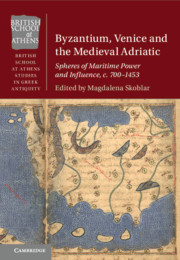Book contents
- Byzantium, Venice and the Medieval Adriatic
- British School at Athens Studies in Greek Antiquity
- Byzantium, Venice and the Medieval Adriatic
- Copyright page
- Contents
- Figures and Maps
- Tables
- Contributors
- Foreword
- Acknowledgements
- Note on Citation, Transliteration, Names, Titles and Dates
- Maps
- Introduction
- 1 The Adriatic Sea 500–1100
- 2 Thinking of Linking
- 3 A Winter Sea?
- 4 The Origins of Venice
- 5 The Northern Adriatic Area between the Eighth and the Ninth Century
- 6 Provincia Iadrensis
- 7 Ravenna and Other Early Rivals of Venice
- 8 Byzantine Apulia
- 9 From One Coast to Another and Beyond
- 10 Icons in the Adriatic before the Sack of Constantinople in 1204
- 11 The Rise of the Adriatic in the Age of the Crusades
- 12 Venice in the Twelfth Century
- 13 Venice, the Ionian Sea and the Southern Adriatic after the Fourth Crusade
- 14 Sea Power and the Evolution of Venetian Crusading
- 15 Reassessing the Venetian Presence in the Late Medieval Eastern Adriatic
- 16 ‘Strangers in the City?’
- Conclusion
- Index
- References
6 - Provincia Iadrensis
Heir of Roman Dalmatia or a Stillborn Child of Byzantine Early Medieval Adriatic Policy?
Published online by Cambridge University Press: 26 March 2021
- Byzantium, Venice and the Medieval Adriatic
- British School at Athens Studies in Greek Antiquity
- Byzantium, Venice and the Medieval Adriatic
- Copyright page
- Contents
- Figures and Maps
- Tables
- Contributors
- Foreword
- Acknowledgements
- Note on Citation, Transliteration, Names, Titles and Dates
- Maps
- Introduction
- 1 The Adriatic Sea 500–1100
- 2 Thinking of Linking
- 3 A Winter Sea?
- 4 The Origins of Venice
- 5 The Northern Adriatic Area between the Eighth and the Ninth Century
- 6 Provincia Iadrensis
- 7 Ravenna and Other Early Rivals of Venice
- 8 Byzantine Apulia
- 9 From One Coast to Another and Beyond
- 10 Icons in the Adriatic before the Sack of Constantinople in 1204
- 11 The Rise of the Adriatic in the Age of the Crusades
- 12 Venice in the Twelfth Century
- 13 Venice, the Ionian Sea and the Southern Adriatic after the Fourth Crusade
- 14 Sea Power and the Evolution of Venetian Crusading
- 15 Reassessing the Venetian Presence in the Late Medieval Eastern Adriatic
- 16 ‘Strangers in the City?’
- Conclusion
- Index
- References
Summary
Early medieval Zadar is the focus of this case study which explores the interaction between international and local factors which contributed to Zadar becoming a capital of a Byzantine province in the late eighth and the ninth century. The chapter examines the local impact of the renovation of Byzantine administration in that period and the relationship between this development and the local Church. Bishops of Zadar tried to use a favourable moment in such a political context to claim the title of archbishops. The study also looks at the interaction between Zadar and its hinterland, populated by Croats, and the new religious centres that served them. Zadar survived the collapse of post-Roman Dalmatia and this Late Antique civitas became an early medieval provincia loosely dependent on the imperial administrative system.
Keywords
- Type
- Chapter
- Information
- Byzantium, Venice and the Medieval AdriaticSpheres of Maritime Power and Influence, c. 700-1453, pp. 133 - 172Publisher: Cambridge University PressPrint publication year: 2021

